We’ve got 15 distinct black bass species across the U.S., each with their own unique characteristics and habitats. From the largemouth’s extended jaw to the smallmouth’s preference for rocky streams, these fighters adapt to diverse environments from lakes to rivers. They’re not just America’s favorite game fish—they’re economic powerhouses too, generating billions in retail sales annually. Grab your rod and join us as we explore these remarkable freshwater champions that have defined American sportfishing for generations.
The Black Bass Family: Nature’s Freshwater Fighters
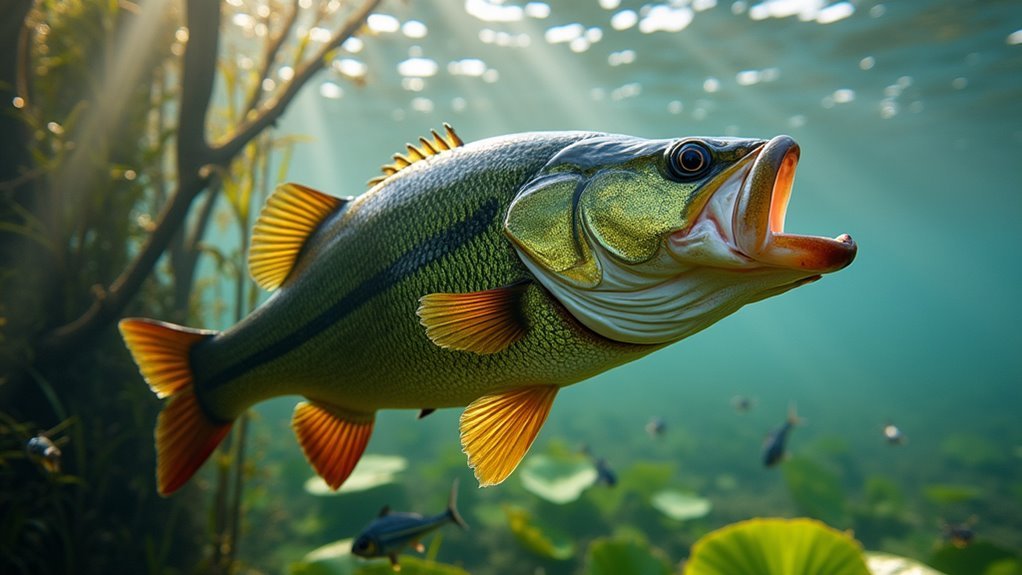
Champions of America’s freshwater habitats, black bass represent the crown jewels of sportfishing in the United States. We’ve tracked these remarkable fighters from Alabama to Texas, discovering 15 distinct species along the way.
From the heavyweight largemouth that once snapped my favorite rod clean in half, to the feisty smallmouth that’ll jump like they’re wearing rocket boosters, each has its own personality.
They’re not just fish—they’re legends with fins. Whether you’re casting near Georgia’s rocky shoals or Texas’s rapid streams, these resilient predators have adapted to diverse waters while maintaining what makes them special: that unmistakable fighting spirit that keeps us coming back.
America’s Most Popular Game Fish Species Explained
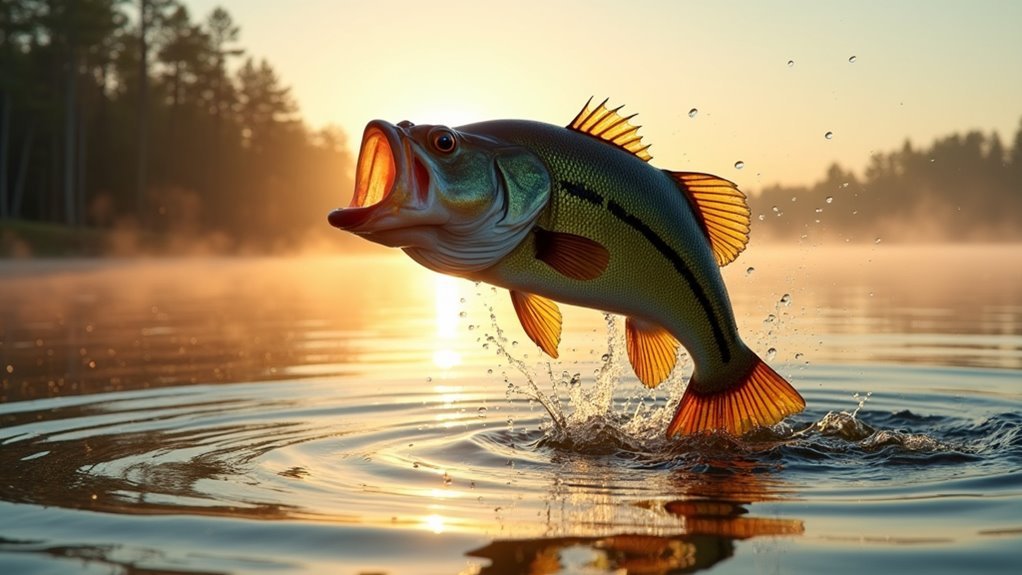
Let’s take a closer look at the stars of America’s freshwater scene. From the heavyweight largemouth to the feisty smallmouth, black bass come in stunning variety. We’ve hooked everything from Alabama bass with their separate lateral blotches to the turquoise-shimmering Suwannee.
Each species has its personality—the Guadalupe loves fast water, while spotted bass resemble largemouths but with smaller mouths. The redeye’s crimson fins make for easy identification when you’re on the water. We’ve found that knowing these differences enhances both fishing success and appreciation for these remarkable creatures that have built a multi-billion-dollar industry.
Identifying Key Features of Different Bass Species
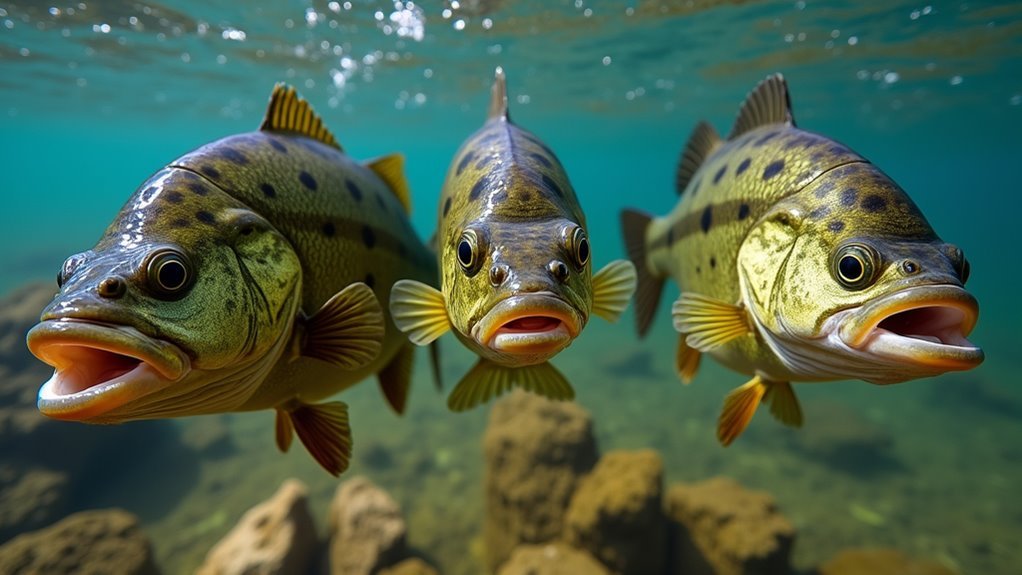
When you’re out on the water trying to identify which black bass you’ve caught, knowing the telltale markers can make all the difference between a routine catch and an exciting discovery. We’ve spent countless hours studying these magnificent fish, and trust me, there’s nothing like the thrill of recognizing a rare Cahaba or Shoal bass!
| Species | Mouth | Eye Color | Distinctive Feature | Preferred Habitat |
|---|---|---|---|---|
| Largemouth | Extends past eye | Normal | Horizontal dark stripe | Lakes, ponds |
| Smallmouth | Ends at eye | Often red | Bronze coloration | Rocky streams |
| Spotted | Ends at eye | Normal | Tooth patch on tongue | Reservoirs |
| Guadalupe | Smaller | Varies | Softer dorsal fins | Fast rivers |
| Redeye | Moderate | Red | Red-tinged fins | Shaded areas |
Regional Bass Varieties and Their Native Habitats
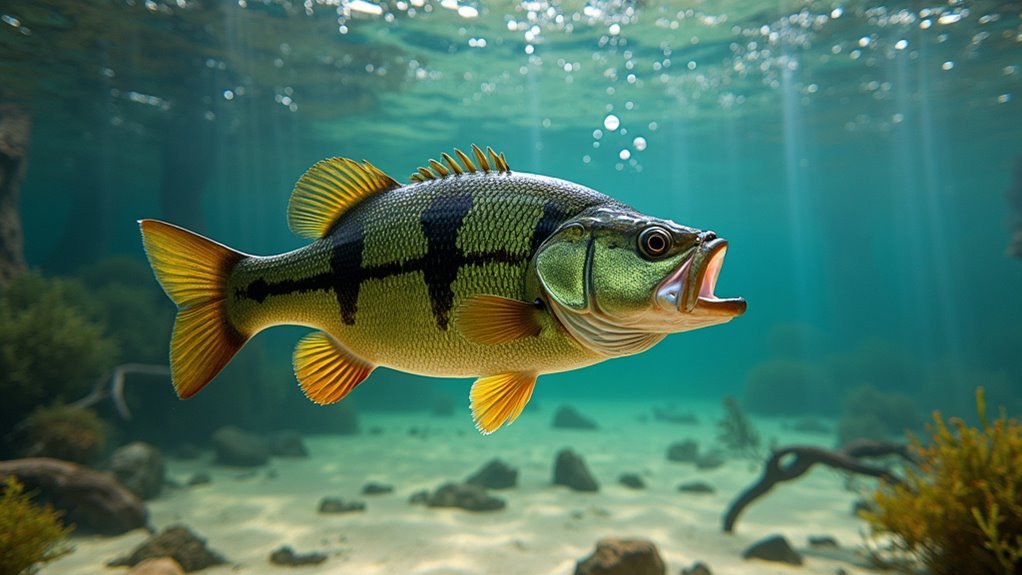
Now that we’ve covered how to identify bass by their physical features, we should examine where these fascinating fish actually live. The black bass family has adapted to diverse waterways across America, each species claiming its own special corner.
You’ll find Alabama Bass in the Mobile River basin, while Florida Bass thrive in the Suwannee watershed. I’ve caught Guadalupe Bass in Texas’s fast-flowing rivers where they navigate rapids like pros. The Shoal Bass prefers Georgia’s Chattahoochee, and the uniquely beautiful Cahaba Bass lives exclusively near Birmingham, Alabama. We once spent three days tracking Redeye Bass along shaded cliff banks – worth every minute!
Conservation Challenges Facing Today’s Bass Populations
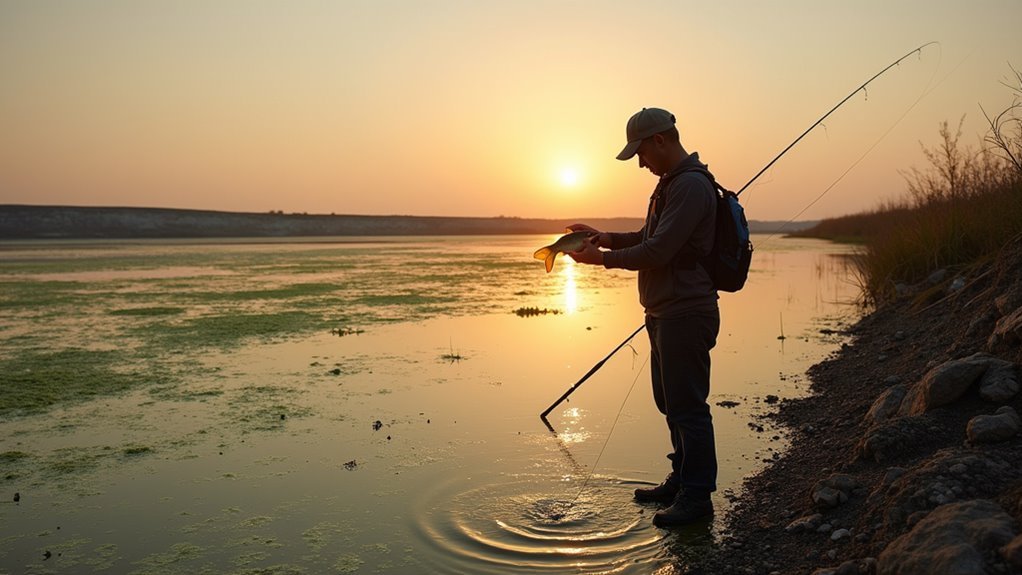
While black bass continue to captivate anglers across America, these iconic fish face mounting threats to their survival. We’re seeing habitat loss everywhere – dams blocking spawning routes and development destroying shoreline vegetation that young bass need to thrive.
Invasive species present another challenge. I’ve watched Alabama bass outcompete native smallmouth in Virginia waters. It reminds me of fishing Lake Norman years ago, where spotted bass had nearly replaced the largemouth population.
Non-native bass introductions, pollution from agricultural runoff, and overfishing also threaten these magnificent fighters. Conservation efforts like catch-and-release and habitat restoration projects are our best hope for preserving these treasured gamefish for future generations.
Fishing Techniques Tailored to Each Bass Species
As each black bass species displays unique behavior and habitat preferences, we’ve got to adapt our fishing techniques accordingly. What works for largemouth won’t necessarily entice a Guadalupe bass in those fast Texas streams. I’ve learned this lesson after many empty hooks!
- Smallmouth bass – Use lighter line and natural presentations; they’re warier than their cousins
- Alabama bass – Try aggressive retrieves near structure; they’re competitive feeders
- Shoal bass – Focus on current breaks with crawfish imitations
- Suwannee bass – Work rocky, shallow areas with small crankbaits
Record-Breaking Bass and Their Remarkable Stories
The history of record-breaking bass captures the imagination of every angler who’s ever felt a powerful tug on their line. We’ve seen some monsters over the years, like the 22-pound, 4-ounce largemouth caught by George Perry in 1932—a record that stood for 77 years!
Florida bass often dominate record books thanks to their impressive growth potential. I remember fishing Lake Okeechobee when a buddy hooked what looked like a submarine. At 13 pounds, it wasn’t record-breaking, but watching his rod bend nearly double reminded us why we chase these magnificent creatures.
The Economic Impact of Bass Fishing in North America
Bass fishing’s billion-dollar boom has transformed what was once just a recreational pastime into a major economic powerhouse across North America. We’ve watched this industry explode over the last few decades, creating jobs and boosting tourism in communities from Florida to Ontario.
- Retail sales of bass fishing equipment top $7 billion annually
- Tournament circuits generate millions in local revenue when they visit towns
- Guide services provide full-time employment for thousands across the continent
- Conservation efforts funded by fishing licenses protect watersheds for future generations
Frequently Asked Questions
Can Bass Species Interbreed in the Wild?
Yes, we’ve found that bass species can interbreed in the wild. Florida bass breed with largemouth bass, and spotted bass interbreed with smallmouth bass, sometimes threatening pure populations of native species.
How Do Seasonal Changes Affect Black Bass Behavior?
Like autumn leaves falling, our bass friends adapt with the seasons. We’ve noticed they move deeper in winter, become aggressive during spring spawning, feed actively in summer, and shift to cooler depths in fall.
What Role Do Black Bass Play in Their Ecosystems?
Black bass are apex predators in their ecosystems. They control prey populations, help maintain water clarity by eating smaller fish, and serve as indicators of environmental health in our freshwater habitats.
Are Any Black Bass Species Suitable for Home Aquariums?
Like athletes in cramped locker rooms, black bass aren’t suitable for home aquariums. They’re territorial predators requiring massive tanks (100+ gallons), pristine water conditions, and specialized care that most hobbyists can’t realistically provide.
How Has Climate Change Specifically Impacted Different Bass Populations?
We’ve seen climate change impact bass populations through warming waters disrupting spawning patterns, shifting habitat ranges northward, and increasing competition between native and invasive species. Drought has also reduced viable habitats in many regions.
Conclusion
We’ve cast our lines across America’s waters and reeled in the fascinating world of black bass. Like the fish themselves, each species has its own unique story to tell. Whether you’re tracking the heavyweight largemouth or searching for the elusive Cahaba, there’s always another bass adventure waiting. We hope you’ll join us in both the thrill of the catch and the vital work of protecting these magnificent fighters for generations to come.